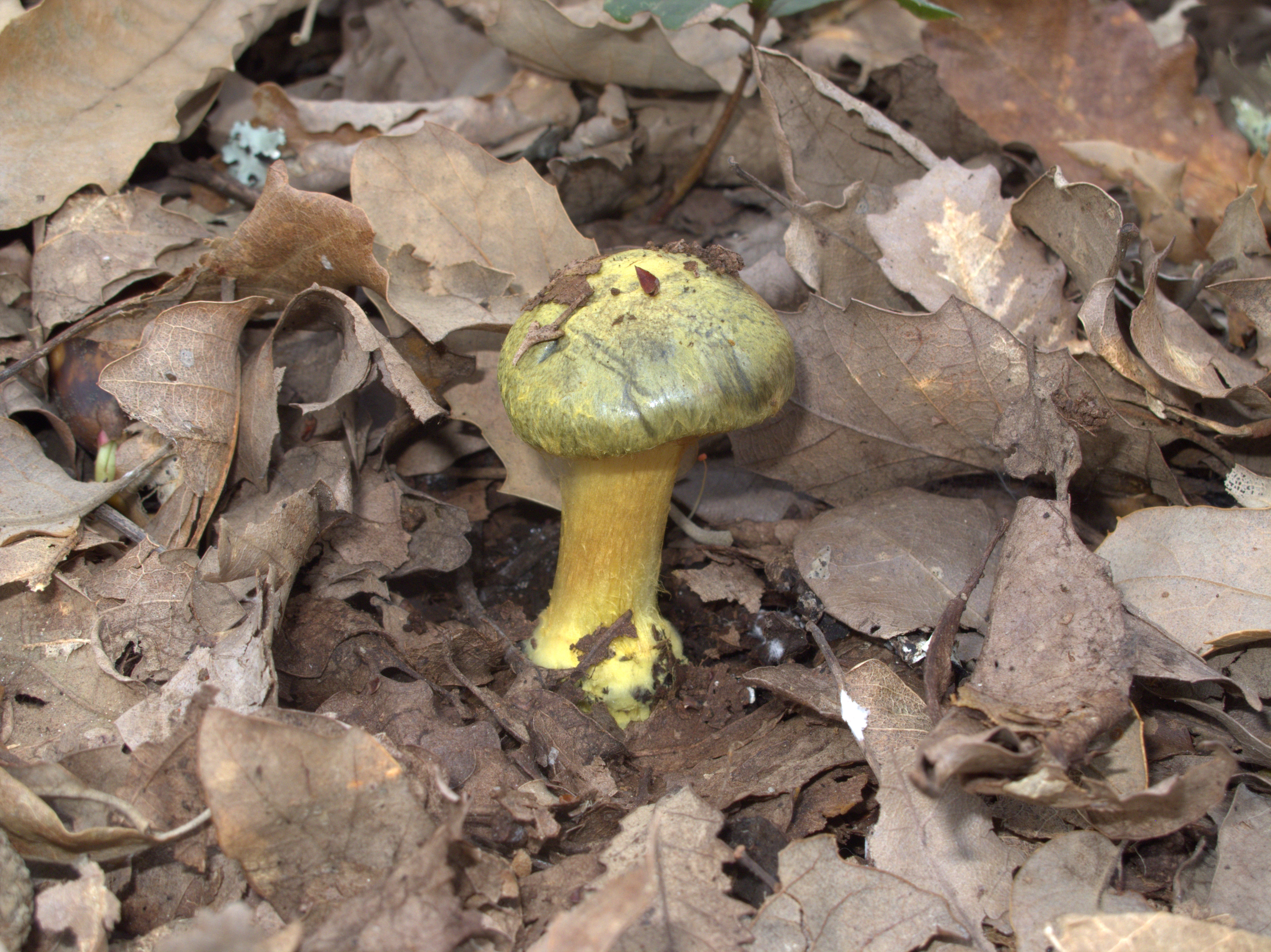- Proposed
- Under Assessment
- Preliminary Assessed
- Assessed
- NTPublished
Cortinarius ionochlorus Maire
- Scientific name
- Cortinarius ionochlorus
- Author
- Maire
- Common names
 Cortinario violeta y verde
Cortinario violeta y verde Violettblättriger klumpfuss
Violettblättriger klumpfuss Cortinaire vert et violet
Cortinaire vert et violet- IUCN Specialist Group
 Mushroom, Bracket and Puffball
Mushroom, Bracket and Puffball- Kingdom
- Fungi
- Phylum
- Basidiomycota
- Class
- Agaricomycetes
- Order
- Agaricales
- Family
- Cortinariaceae
- Assessment status
- Published
- Assessment date
- 2019-03-26
- IUCN Red List Category
- NT
- Assessors
- Gonçalves, S.C.
- Reviewers
- Mueller, G.M.
Assessment Notes
Justification
Cortinarius ionochlorus is an ectomycorrhizal species associated with trees in the Fagaceae, typically evergreen oaks in the Mediterranean basin. The conservation status of its most common habitat is reported by the EU Habitat Directive as “unfavourable-inadequate”. Major threats relate to continuous habitat reduction and decline in quality. Assessed as Near Threatened under criteria A2c+A3c+A4c because of inferred past and ongoing population decline of 20% over three generations (50 years).Taxonomic notes
Cortinarius ionochlorus is phylogenetically very similar to C. atrovirens (w/ e.g. identical ITS sequences; Garnica et al. 2003, 2009). However, morphologically and eco-geographically these are clearly dissimilar, and should be treated as different taxa, either as different species or subspecies (C. atrovirens subsp. atrovirens and subsp. ionochlorus). For practical reasons, we treat these as species in the present assessment.Geographic range
Cortinarius ionochlorus has only been reported from eight countries in Europe (Portugal, Spain, Belgium, France, Italy, Germany, Czechia, Croatia) and Morocco and Israel; it is mostly present in south-western Europe, especially in the Mediterranean.Population and Trends
Uncommon and declining due to threatened habitat and decline in numbers of appropriate host trees. Fraiture and Otto (2015) reported the number of known sites to be around 180. The GBIF site lists 70 records under Cortinarius ionochlorus (Spain, 50; France, 11; Italy, 3; Morocco, 3; Czechia, Austria and Germany each with 1). The species is quite distinctive and easy to recognize. Yet, the numbers of reported sightings remain low. There are an estimated 2,000 sites each with 10-20 mature individuals.
Mediterranean forests dominated by C. ionochlorus' primary host, Holm Oak (Quercus ilex and Q. rotundifolia- also referred to as Q. ilex subsp. ballota) are the most common habitat of the species. These forests have been strongly influenced by human activities during the last millennia due to wood exploitation, species mixture modifications or substitution, livestock grazing and fires. All these disturbances have led to a degradation and, in many cases, Holm Oak forests have been completely replaced by agriculture and urban settlements (de Rigo and Caudullo 2016). Cortinarius ionochlorus thus often occurs only in small remnants. Holm Oak is susceptible to pathogens, esp. Phytopthora spp. under increased drought stress. The "Mid-term review of the EU biodiversity strategy towards to 2020" (European Commission 2015) assessed the conservation status of these woodlands as “unfavourable-inadequate”. In Central Europe, the species associates with Fagus woodlands on non-acid soils, classified as near threatened in the Red List of European Habitats (Janssen et al. 2017). Given this past and ongoing loss of its obligate hosts, the population of C. ionochlorus is inferred to be declining by at least 20%.
Population Trend: decreasing
Habitat and Ecology
Cortinarius ionochlorus is typically found in species-rich natural and semi-natural woodlands on calcareous soils. It is ectomycorrhizal with broad-leaved trees in the Fagaceae, usually evergreen oaks (notably the Holm Oak), more rarely deciduous oaks (e.g. Quercus faginea) and Beech (Fagus).Typical habitats include different Quercus-dominated woodlands in the Mediterranean region and F. sylvatica woodlands in central Europe.
The species occurs in the following NATURA 2000 forest habitats: 6310, 9130, 9150, 91H0, and 9340 (Q. ilex and Q. rotundifolia forests; the most frequent habitat).
Threats
In Mediterranean habitats, where the species mainly occurs, major threats relate to continuous habitat reduction by forest clearance, fragmentation and loss of habitat connectivity, and modification of semi-natural woodlands management regimes, e.g. overgrazing by sheep and goats. Climate change is also becoming a more and more important threat with increased devastating wildfires and pervasive drought stress. Under water stress conditions evergreen oaks, e.g., Q. ilex, are highly vulnerable to pathogens like Phytophthora spp. (e.g. P. cinnamomi) and Cryphonectria parasitica that may affect holm oak as a synergistic negative combination with abiotic factors. Outside the Mediterranean area, airborne nitrogen deposition is a major threat to naturally nutrient-poor woodlands.Conservation Actions
In its most common habitat, needed conservation actions include establishing protected areas and carrying out appropriate woodland management practices, e.g. preventing overgrazing. Management plans can play a role in increasing the conservation status of the species even if sites are within the Natura 2000 network. Restoring habitats often takes many years, especially for woodlands/forests so it is not a practical measure. Also, note that protected well-managed areas cannot address pressures such as climate change.Roughly half of localities occur outside protected areas (European Environmental Agency, 2007-2012). Thus, securing adequate funding for biodiversity-favourable measures remains a challenge. Improving EU-level information on forest status will allow a more precise assessment of the situation and the design of appropriate policy responses.
Research needed:
Genetic studies with additional molecular markers are needed to find out more about the (subtle) phylogenetic differentiation between C. ionochlorus and C. atrovirens.


